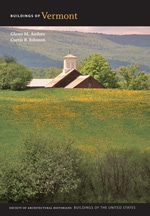
The Parade at Norwich University is a notable formal space shaped by relatively neutral buildings. This oldest private military school in the United States had been founded in Norwich in 1819, but its major building there burned in 1866. The school moved to Northfield in response to an offer of suitable grounds and commodious barracks. That same year General Alonzo Jackman surveyed a site on a prominent ridge and local farmers began grading the ridgetop. The first building was erected at its northern end. In 1870 further grading and trees defined the elevated north–south parade as an elongated rectangle for drills and encampments. Jackman's mansard-roofed barracks, Jackman Hall (1866–1868; demolished 1964), set a general three-story scale for the campus, though the ultimate character of the space was established by the construction of Alumni Hall on its western side in 1905. Designed by Frank A. Walker of Montpelier, this elongated dormitory block of brick with concrete detailing is three stories high along its parade side and gains an additional floor on its downslope. Over the course of the next sixty years, and especially under the presidency of Major General Ernest N. Harmon, similar buildings completely enclosed the perimeter of the parade. An excep tion to the uniformity is Chaplin Hall, built as a library in 1908, and now housing one of Vermont's two degree programs in architecture. A new Jackman Hall replaced the original at the northern end of the parade in 1965. Also built of brick with three stories, its Colonial Revival portico and crowning cupola mark the parade's central axis. The result is a tightly defined space reminiscent of a Georgian London square—neutral red brick walls of uniform scale and with decorative entrances that frame a handsome, tree-lined green—crossed with Thomas Jefferson's Lawn at the University of Virginia.

